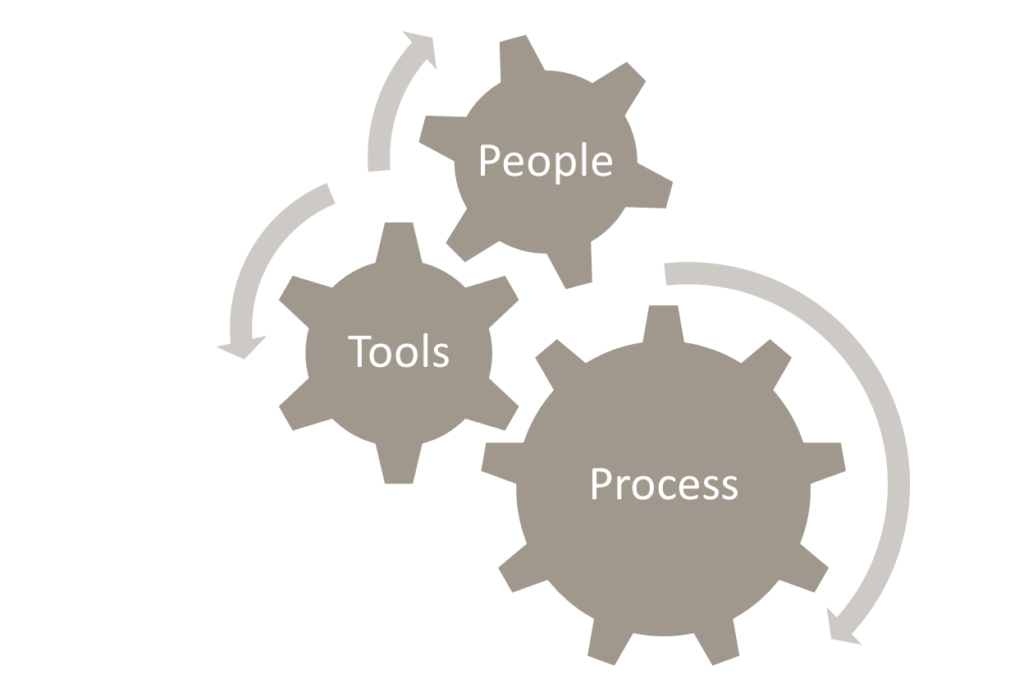Unleashing Change: The Three Levers of Agile Leadership for Achieving Desired Outcomes
Agile leaders have three ways or levers in which they can affect change that allows the entity to achieve desired outcomes. These are – Process, Tools, and People.

Process is the way work is done across a department or organization to the benefit of an end client. It is how the people actually do the work- not what might be written in a procedure manual. A process is what the end user experiences. Quite often a process will cross departments or silos, which is how the end user sees the process. Sometimes this end user is your client and sometimes it may be an internal person. Ideally you are looking at a process that impacts your clients from start to finish.
The tools are the machines and equipment that people use to get their work done. In an office environment, tools can be a computer, a desk, chair, software, and phones.
People are all the employees that touch the process. You are seeking to understand their roles, training, and experiences.
Every entity can assure each lever is running at peak performance to achieve the desired results. It is leadership’s responsibility to embrace the need for continuous improvement actions while respecting all the people involved in the process. If you examine top performing companies, you will find deep understanding of each of the levers and how to impact continuous improvement.
If you think about these three areas- process, tools, and people, which one can have the most impact? You might say we need the best people and you do need that. You might say leading edge software will allow us competitive advantage. Or you might say how we get the work done through our processes achieves our results. And each of these is partly correct.
Having good people and excellent tools in bad processes won’t get results. Good processes with poor tools and untrained people won’t get results. What we want are good processes with the right tools and training will get the best results. So why does it seem that so many organizations don’t focus on processes in a way that affects results? Maybe it is just easier to hire a new person and let their experience be inserted into the culture of how work is done here. But they’re stuck in this old process that that they cannot really see with tools that they may not want and so the next thing they’ll do is ask for new tools and those new tools will be inserted into the existing process. Many times, leadership maximizes impact within their control and so they may have a good process, but the rest is below
average. The end user is still unsatisfied. The idea of looking at processes in detail is arduous work. It exposes how the actual organization is working today including the good, the bad, and the ugly.
When you use lean management methodology, you learn that process management is the key to success and that rigorous continuous improvement of the process brings outstanding results. It helps you uncover the true potential of your people and the tools they use. People have increasing satisfaction with their work because it has more value to the end user. The employee sees leadership valuing their capabilities and they feel a part of the decision-making process.
My experience is that many in the private sector have already embraced lean management methodology. In nonprofit organizations and higher education this can be a new experience. At the Agile Strategy Lab, we have been engaged to use our methodology called “Rapid Improvement” in over 50 events at our university and with other clients. I encourage you to explore this area as you seek to improve your organization. If you are in higher education a good place to start is the annual “Lean in HE Conference” held this year in San Diego. You can learn more at leanhe2023.ucsd.edu. If you want to learn more about what we are doing here, contact me.

Janyce Fadden is Director of Strategic Engagement at the UNA College of Business & Technology, which hosts the UNA Agile Strategy Lab. A co-author of Strategic Doing: 10 Skills for Agile Leadership, she focuses on innovation pipeline strategy and other business engagement projects.
